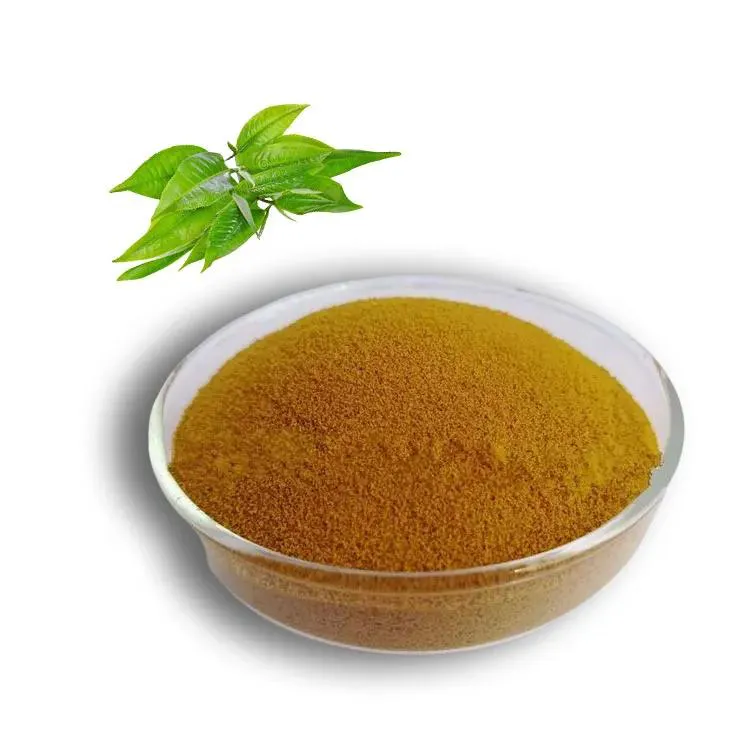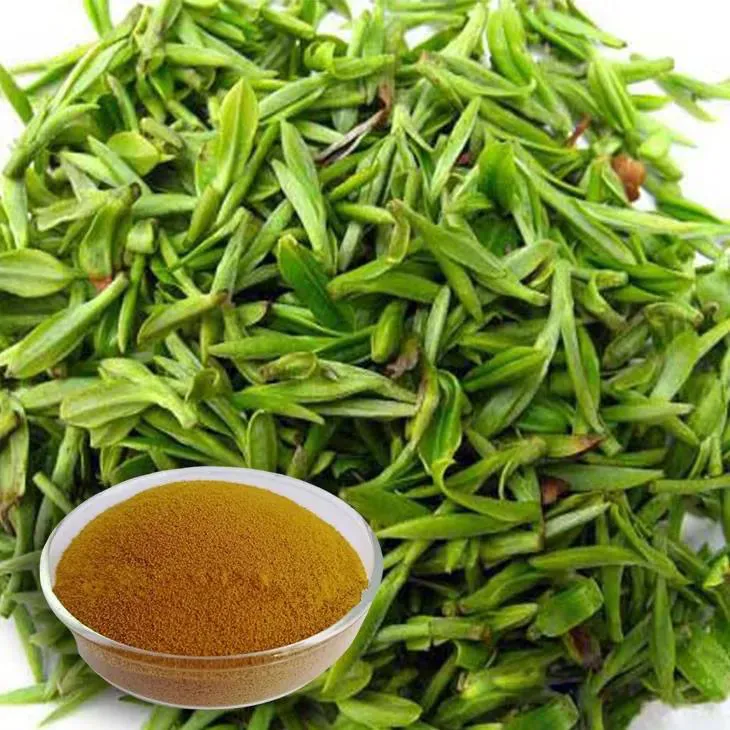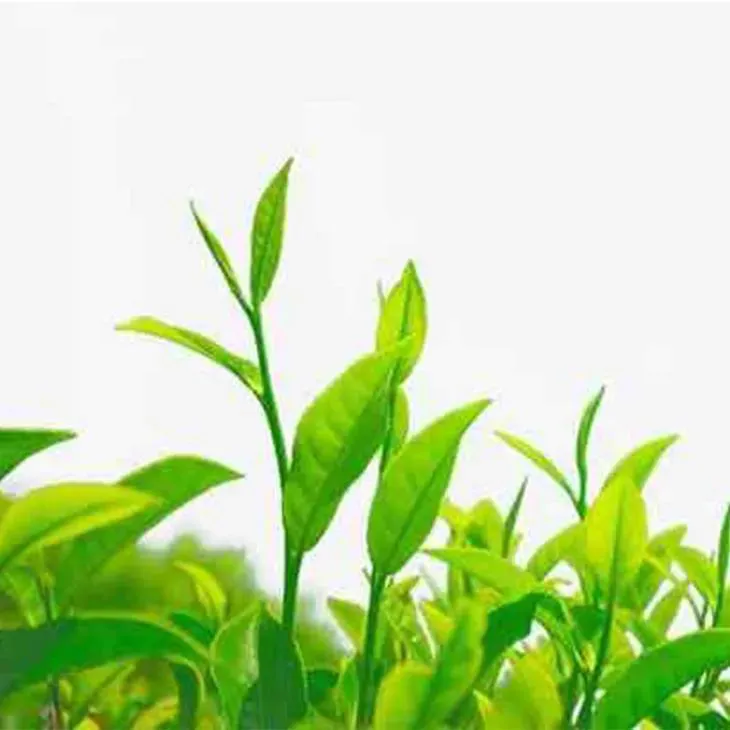- 0086-571-85302990
- sales@greenskybio.com
Extraction Technology and Production Process of Green Tea Extracts
2024-11-29

1. Introduction
Green tea has been a popular beverage for centuries, not only for its refreshing taste but also for its numerous health benefits. Green Tea Extracts are concentrated forms of green tea that contain bioactive compounds, which have attracted significant attention in various fields such as medicine, nutrition, and cosmetology. The extraction technology and production process play a crucial role in obtaining high - quality Green Tea Extracts.

2. Bioactive Compounds in Green Tea
Green tea is rich in a variety of bioactive compounds, which are the main reasons for its health - promoting properties. These compounds include:
- Catechins: Catechins are the most abundant polyphenols in green tea. The main catechins in green tea are epicatechin (EC), epigallocatechin (EGC), epicatechin - 3 - gallate (ECG), and epigallocatechin - 3 - gallate (EGCG). EGCG is considered to be the most biologically active component, with strong antioxidant, anti - inflammatory, and anti - cancer properties.
- Caffeine: Caffeine is a well - known stimulant that can enhance mental alertness and reduce fatigue. In green tea, caffeine is present in a relatively small amount compared to coffee, and it may interact with other compounds in green tea to produce different effects.
- Theanine: Theanine is an amino acid unique to tea plants. It has a relaxing effect on the nervous system and can improve mood and reduce stress. Theanine also has the ability to enhance the absorption of catechins in the body.

3. Traditional Solvent - Based Extraction Methods
3.1. Water Extraction
Water is a commonly used solvent for Green Tea Extraction. The process is relatively simple and environmentally friendly. Hot water extraction is often used, in which green tea leaves are soaked in hot water at a certain temperature for a period of time. During this process, the water - soluble bioactive compounds in green tea, such as catechins and caffeine, are dissolved into the water. However, water extraction may have some limitations. For example, it may also extract some impurities, resulting in a relatively low - purity extract.
3.2. Organic Solvent Extraction
Organic solvents such as ethanol, methanol, and ethyl acetate can also be used for green tea extraction. These solvents have different polarities and can selectively extract different bioactive compounds. For example, ethanol is a relatively mild solvent that can effectively extract catechins. However, the use of organic solvents also has some problems. First, some organic solvents are flammable and toxic, which pose safety risks during the production process. Second, the extraction process may require complex purification steps to remove the residual solvents, which may increase the production cost and affect the purity of the final product.

4. Modern Extraction Techniques
4.1. Enzymatic - Assisted Extraction
Enzymatic - assisted extraction is a modern and promising technique for green tea extraction. Enzymes can break down the cell walls of green tea leaves, which helps to release the bioactive compounds more effectively. Commonly used enzymes in green tea extraction include cellulase, pectinase, and protease. For example, cellulase can hydrolyze the cellulose in the cell walls, making the cell walls more permeable. This allows the solvent to more easily access the interior of the cells and extract the bioactive compounds. Enzymatic - assisted extraction can improve the extraction efficiency and purity of green tea extracts, and it is also more environmentally friendly compared to some traditional extraction methods.
4.2. Supercritical Fluid Extraction
Supercritical fluid extraction (SFE) is another advanced extraction technique. Supercritical fluids, such as supercritical carbon dioxide (sc - CO₂), have properties between those of gases and liquids. They have high diffusivity and low viscosity, which can penetrate into the matrix of green tea leaves quickly. In addition, supercritical fluids can be easily separated from the extract by simply changing the pressure and temperature conditions. SFE can selectively extract the desired bioactive compounds with high purity. However, the equipment for SFE is relatively expensive, which may limit its widespread application in the industry.
5. Production Process of Green Tea Extracts
5.1. Pretreatment of Green Tea Leaves
The pretreatment of green tea leaves is the first step in the production process of green tea extracts. This step mainly includes:
- Washing: Green tea leaves are washed to remove dust, dirt, and other impurities on the surface. This helps to ensure the purity of the final extract.
- Drying: After washing, the green tea leaves need to be dried. Drying can reduce the moisture content of the leaves, which is beneficial for subsequent extraction. There are different drying methods, such as air drying, oven drying, and freeze - drying. Each method has its own advantages and disadvantages. For example, air drying is a natural and simple method, but it may take a long time. Oven drying can quickly reduce the moisture content, but it may affect the quality of some bioactive compounds if the temperature is not properly controlled. Freeze - drying can better preserve the structure and bioactivity of the bioactive compounds, but it is relatively expensive.
5.2. Extraction
During the extraction process, different extraction methods can be selected according to the specific requirements. The key parameters that need to be optimized include:
- Temperature: The extraction temperature has a significant impact on the extraction efficiency and the quality of the extract. For example, in water extraction, if the temperature is too high, it may cause the degradation of some bioactive compounds. On the other hand, if the temperature is too low, the extraction efficiency may be low.
- Time: The extraction time also affects the extraction results. Longer extraction time may increase the yield of the extract, but it may also extract more impurities.
- Solvent - to - material ratio: The ratio of the solvent to the green tea leaves affects the concentration of the extract. A higher solvent - to - material ratio may result in a more dilute extract, while a lower ratio may lead to incomplete extraction.
5.3. Refining of the Extract
After extraction, the green tea extract needs to be refined to remove impurities and improve its purity. The main refining processes include:
- Filtration: Filtration is used to remove solid particles, such as tea residues and cell debris, from the extract. There are different filtration methods, such as gravity filtration, vacuum filtration, and membrane filtration. Membrane filtration is a more advanced method that can effectively remove small - sized impurities.
- Concentration: Concentration is carried out to increase the concentration of the bioactive compounds in the extract. This can be achieved by methods such as evaporation under reduced pressure or ultrafiltration. During the concentration process, it is necessary to control the temperature and pressure to avoid the degradation of the bioactive compounds.
5.4. Drying of the Extract
The final step in the production process of green tea extracts is drying. Drying can convert the liquid extract into a solid form, which is more convenient for storage, transportation, and use. Commonly used drying methods include spray drying and freeze - drying. Spray drying is a relatively fast and cost - effective method, which can produce a powder - like green tea extract. Freeze - drying can better preserve the quality of the extract, but it is more expensive.
6. Market Prospects of Green Tea Extracts
Green tea extracts have broad market prospects in various fields due to their rich bioactive compounds with antioxidant, anti - inflammatory, and other beneficial effects.
6.1. Medical Field
In the medical field, green tea extracts are being studied for their potential in preventing and treating various diseases. For example, the antioxidant properties of catechins in green tea extracts may help to prevent oxidative stress - related diseases, such as cardiovascular diseases, neurodegenerative diseases, and cancer. In addition, some studies have shown that green tea extracts may have antibacterial and antiviral effects, which can be used in the development of new drugs.
6.2. Nutrition Field
Green tea extracts are also widely used in the nutrition field. They can be added to various foods and beverages as a natural antioxidant and functional ingredient. For example, green tea extracts can be added to sports drinks to enhance their antioxidant capacity and improve the performance of athletes. In addition, green tea extracts can be used in dietary supplements to provide consumers with the health benefits of green tea.
6.3. Cosmetology Field
In the cosmetology field, green tea extracts are highly valued for their antioxidant and anti - inflammatory properties. They can be used in skin care products, such as creams, lotions, and masks, to protect the skin from free radical damage, reduce inflammation, and improve skin health. Green tea extracts can also be used in hair care products to promote hair growth and prevent hair loss.
7. Conclusion
The extraction technology and production process of green tea extracts are continuously evolving. Modern extraction techniques, such as enzymatic - assisted extraction and supercritical fluid extraction, offer new opportunities to improve the quality and efficiency of green tea extraction. The production process of green tea extracts involves multiple steps, including pretreatment, extraction, refining, and drying, and each step needs to be carefully controlled to obtain high - quality products. With the increasing awareness of the health benefits of green tea, green tea extracts have broad market prospects in the fields of medicine, nutrition, and cosmetology.
FAQ:
What are the main bioactive compounds in green tea?
Green tea is rich in polyphenols (such as catechins), flavonoids, caffeine, and amino acids like L - theanine. These bioactive compounds contribute to the various beneficial effects of green tea, such as antioxidant, anti - inflammatory, and antibacterial properties.
What are the limitations of traditional solvent - based extraction methods for green tea extract?
Traditional solvent - based extraction methods may have issues regarding purity and efficiency. They might not be able to extract all the desired active ingredients completely, and there could be problems with solvent residues in the final extract, which may affect the quality and safety of the product.
How does enzymatic - assisted extraction improve the extraction of green tea extract?
Enzymatic - assisted extraction can break down the cell walls of green tea leaves more effectively. Enzymes can target specific components in the cell walls, making it easier for the active ingredients to be released. This results in a higher yield of the desired bioactive compounds compared to traditional methods.
What are the key parameters to optimize during the extraction stage of green tea extract?
Parameters such as extraction time, temperature, solvent type and concentration, and the ratio of solvent to green tea leaves need to be optimized. The right combination of these parameters can ensure the maximum extraction of bioactive compounds while minimizing the extraction of unwanted substances.
What are the applications of green tea extract in the field of cosmetology?
Green tea extract is used in cosmetology for its antioxidant properties. It can help protect the skin from free radical damage, reduce signs of aging such as wrinkles and fine lines, and has anti - inflammatory effects that can soothe irritated skin. It may also be used in hair care products to improve the health of the scalp and hair.
Related literature
- Green Tea Extract: Chemistry, Antioxidant Properties and Applications"
- "Advances in Green Tea Extraction Technology: A Review"
- "The Production and Utilization of Green Tea Extract in the Nutraceutical Industry"
- ▶ Hesperidin
- ▶ citrus bioflavonoids
- ▶ plant extract
- ▶ lycopene
- ▶ Diosmin
- ▶ Grape seed extract
- ▶ Sea buckthorn Juice Powder
- ▶ Beetroot powder
- ▶ Hops Extract
- ▶ Artichoke Extract
- ▶ Reishi mushroom extract
- ▶ Astaxanthin
- ▶ Green Tea Extract
- ▶ Curcumin Extract
- ▶ Horse Chestnut Extract
- ▶ Other Problems
- ▶ Boswellia Serrata Extract
- ▶ Resveratrol Extract
- ▶ Marigold Extract
- ▶ Grape Leaf Extract
- ▶ blog3
- ▶ Aminolevulinic acid
- ▶ Cranberry Extract
- ▶ Red Yeast Rice
- ▶ Red Wine Extract
-
Calendula Extract
2024-11-29
-
Hesperidin
2024-11-29
-
American Ginseng Root Extract
2024-11-29
-
Honeysuckle Pollen
2024-11-29
-
Chia Seed Powder
2024-11-29
-
Chaste Berry Extract
2024-11-29
-
Grapefruit Seed Extract Powder
2024-11-29
-
Nutmeg Extract
2024-11-29
-
Black Rice Extract
2024-11-29
-
Echinacea Extract
2024-11-29





















